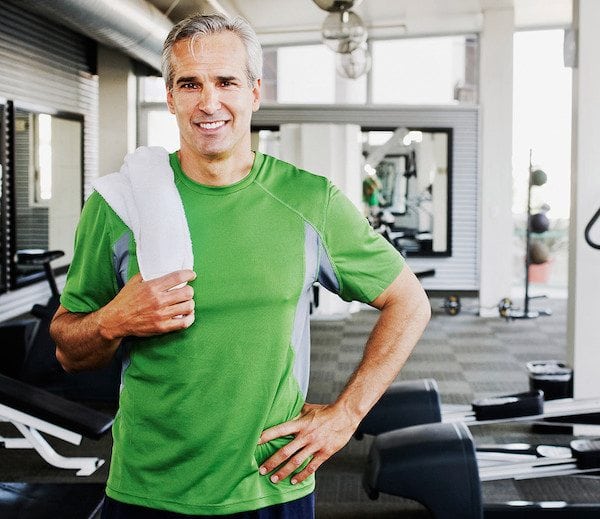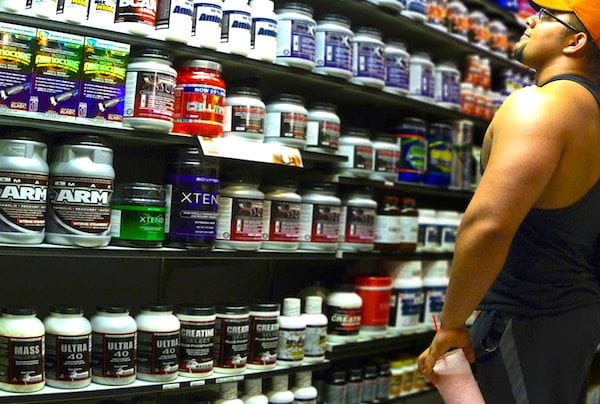No products in the cart.
Muscle Building After 40 – Is it Possible?

So you’ve just turned 40, or you’re 41 and have spent a year making the most of that mid-life crisis.
Two thousand years ago you’d probably be dead by now, falling asleep in front of the fire surrounded by your great-grandchildren and then getting killed by a Roman soldier (statistically the most likely cause of death in the year 18AD).
But now thanks to a better diet and some amazing medical breakthroughs, random Roman soldier-related deaths are a thing of the past!
Instead of worrying about retirement, or reduced virility, many 40-year-olds are worrying about how to get a killer six-pack, or whether they can break their personal deadlift record.
How cool is that? In the last 20 years, we have completely changed how we see people over 40.
If you’re over 40 you are no longer an elder that is in need of help and respect. You’re just another gym-goer, who’s probably stronger than most of the teenagers strutting around in string vests and trucker caps.
So what is the purpose of this article? Well, other than teaching you some questionable history/statistics lessons. The purpose of this article is to tell you everything that you need to know if you want to build muscle after 40 years old. We’ll identify common issues, and find easy solutions.
This article will be mostly aimed at men – but if you’re a 40+ year old woman reading this then you should be able to get a lot of information out of it (just avoid all the talk about Viagra).
The main difference between men and women when it comes to building muscle is hormonal, but the nutrition, fitness and lifestyle information is completely the same.[toc]
What Happens As You Age?

Ageing is an interesting thing, it can certainly make muscle building difficult – but is nowhere near as bad as you’d think.
This misconception that age directly causes loss of muscle mass is due to correlation vs causation [1].
As we age we get weaker, testosterone levels drop, body fat increases, and our metabolism slows.
But it isn’t the ageing process itself that causes this. Let’s look at it another way.
As you grow older your activity levels often drop, unless you’re one of those awful retired people that take up hiking just to irritate your sedentary friends and family.
You may have picked up some injuries, or just not been able to find the time, what with family, friends, and work getting in the way. As a result, your strength levels will drop – something that would happen to anyone who exercises less than they did previously.
That loss of strength and the reduction in activity can lead to a reduction in your metabolism, while muscle doesn’t burn as many calories as you’d think, losing muscle will only lead to a slower metabolic rate.
As your activity levels drop, your energy expenditure also drops, which can lead to increased body fat.
Increased body fat can lead to reduced testosterone as adipose tissue creates the enzyme aromatase which converts testosterone to estrogen [2].
Low testosterone levels and increased body fat can affect sleep quality and duration which leads to a bad night. This can cause increased hunger the next day, and many people who sleep badly gain weight through bad diets.
Poor sleep actually leads to you prioritising high-calorie foods over healthy foods. Bad sleep can also increase stress, which can lead to raised cortisol [3].
In healthy amounts, cortisol has many benefits, but prolonged periods of time with elevated cortisol can lead to further reductions in testosterone, increased body fat, and bad sleep.
It’s all a horrible cycle, where each bad thing leads to a further bad thing.
The trigger doesn’t have to be age, it could be anything. In fact, it is often stress. But as you age, it becomes more difficult to break out of this cycle, this is often a psychological issue more than anything else!
How to Build Muscle After 40 (Exercise)

Okay, enough about how old we’re all getting. How do we change this?
The first thing that you should ensure is that you are getting the basics right. No matter what age you are, you should be training consistently – whether it’s three, five, or seven days per week.
You should be following a strength or hypertrophy related training program that incorporates free weights, bodyweight movements, and resistance machines. I would also suggest that you consider some cardio … you know … because you’re old.
Steady-state cardio, 20-60 minutes at least once per week will help reduce body fat, improve your conditioning, and help strengthen your heart. It can also reduce your stress levels and keep cortisol down [4].
If you hate cardio then you should consider increasing your daily step count (10,000 is the traditional target for steps, but anything over 5,000 is decent).
You could also seriously consider taking up some form of sport – it will make cardio fun, and will tie in nicely with that mid-life crisis that you’re supposed to be enjoying right now.
The training program should be aimed at building bigger muscles, this is known as hypertrophy.
This form of training involves using a mix of rep ranges. Some low rep (1-6), some medium rep (8-12), and some high rep (15+). Your rest times in between sets should be around 3 minutes as this has been shown to be the most effective rest time for recovery.
Below is an example of a workout that you can follow to get excellent hypertrophy results, obviously there are many different workouts that can help you. But this is a perfectly decent program and you will get great results provided that you follow it consistently and can be patient!
Muscle Building Training Plan (4 x per week)
Monday
- Leg curls: 3 x 12-15
- Back Squats: 3 x 6-8
- Walking Lunges: 3 x 10
- Bench Press: 3 x 12-15
- Bent-Over Row: 3 x 12-15
- Seated Shoulder Press: 3 x 8-12
Tuesday
- Rest
- Walk: 6-10,000 steps
- Ab Crunches: 3 x 15-20
Wednesday
- Goblet Squats: 3 x 12-15
- Deadlifts: 3 x 6
- Leg Extensions: 3 x 12-15
- Push-Ups: 3 x 12-20
- Assisted Pull-Ups: 3 x 12-15
- Rear Delt Flys: 3 x 20
Thursday
- Rest
- Walk: 6-10,000 steps
- Long Arm Crunches: 3 x 12-15
Friday
- Romanian Deadlifts: 3 x 8-12
- Leg Press: 3 x 8-12
- Smith Machine Calf Raises: 3 x 25
- Assisted Dips: 3 x 12
- Lat Pulldown: 3 x 8-12
- Barbell Push Press: 3 x 8-12
Saturday
- Rest
- Walk: 6-10,000 steps
- Plank
Sunday
- Nordic Curls: 3 x 12
- Barbell Squats: 3 x 12-15
- Split Squats: 3 x 12
- Bench Press: 3 x 8-12
- Single Arm Row: 3 x 10
- Dumbbell lateral Raises: 3 x 20
Feel free to move the exercises around, swap out exercises that you find too easy/difficult, and change the days to suit your lifestyle. Time your rest periods between each set for 3 minutes, and stay hydrated throughout the workout.
As mentioned above, you can replace the walking with cardio, either HIIT or low-intensity steady-state cardio (running on a treadmill for 40-60 minutes).
How To Avoid Injury
At this point in life, be mindful that your body will be more susceptible to injuries, so here are some changes you need to make to your training routine:
a) Warm up for at least 15 minutes before weight lifting to increase core temperature and blood flow.
b) Keep repetition in a moderate to high range. For upper body exercises, 8-12 reps, and for the lower body, 12-20 is enough.
c) As you age, the stabiliser muscles weaken, leaving tendons, and ligaments open to injury. To avoid this risk, make use of free weights and machines.
d) Poor form can easily cause injury at this age, so make sure your posture is perfect.
e) At this age, you might have to decrease your gym commitments and increase the rest period between workouts. Also, keep your training session to 40 minutes or less. Nothing more than that.
Rest & Recovery for Over 40s

Back when you were in your 20s you could probably run a hundred miles, kill a dinosaur (it was a while ago right?) go for several beers afterwards and wake up the next day feeling absolutely fine.
These days recovery is a trickier thing to achieve. Do five bodyweight squats and you’ll be hearing about it from your screaming muscles for days.
This isn’t much of an issue, you just need to make sure that your rest and recovery process is as good as possible.
The first thing you should do is ensure that you are sleeping enough. As we age the amount of time that we need to sleep tends to get smaller and smaller. But you need to buck this trend.
Getting 8-10 hours of sleep each night is a must, particularly if you are training at a high intensity. Finding ways to improve your sleep quality is also important [5].
Having a scheduled bedtime that you follow each night is a good start, as is having a scheduled wake up time.
Your body will adjust to this pretty fast, and you’ll start falling asleep on cue. You’ll also wake up feeling more refreshed.
Meditation may sound like a load of hippie nonsense, but it actually can help you to fall asleep – mostly because it involves being very quiet and listening to your breathing, who wouldn’t fall asleep to that?
Foam rolling may help you to reduce soreness and stiffness in your muscles after a workout, though the science behind this is conflicted.
Taking an aspirin can help reduce delayed onset muscle soreness after a workout, as can taking caffeine. But for the first week or so of training, you may just have to grin and bear it.
Diet for Those 40 And Over
What you eat, and how much is dependent on your current physical shape and your desired one.
If you are very overweight and looking to build muscle (as well as lose some body fat) then you are going to have a very different looking diet to someone who is very skinny and looking to increase their mass.
If you are overweight and looking to build muscle while losing fat you should aim for a calorie target that is slightly lower than maintenance.
You will have enough energy through stored body fat to fuel exercise while being in a slight calorie deficit. You should see decent results for the first few months of training.
Eventually, you’ll need to concentrate on either fat loss or muscle building if you want to see real results. But for initial success, you can have your cake and eat it (not literally).
If you are an underweight guy then you’ll need to create a calorie surplus. This is where you consume more calories than you burn.
The extra calories will be used to create muscle tissue and lead to bigger muscle size. Do this by finding your maintenance calories and increasing that number by 50-100 each week for a 12 week period.
Whichever goal you have you’ll need to drastically increase your protein to calorie ratio. You want about 35-40% of your calories to come from protein.
This will help with muscle gain, recovery, and training. It will also help you improve your body composition.
As you get older you require more and more protein to stimulate protein synthesis. So bear this in mind and get that protein intake up.
Supplementation Ideas for Over 40s

You’ll want some whey and casein protein in your diet (for the reasons we mentioned in the diet section). You might also want to take creatine as it can really help increase energy during a workout and allow for more power and endurance.
Natural testosterone supplements may also be useful as your testosterone levels may be quite a bit below average by now.
Final Thoughts
As you have probably noticed a lot of the advice in this article could easily apply to a teenager just as much as it could apply to an octogenarian.
Exercise consistently, get lots of rest and recovery between workouts, eat lots of protein, take supplements, and sleep for 8+ hours each night.
There’s a reason for that, as we alluded to at the beginning being older is just a state of mind for the most part.
You may take a little longer to recover, you may need to negotiate your way through slightly more injuries and illnesses than your average 22-year-old, but in terms of staying healthy and building muscle, it’s all the same.

Hi, My name is Rick and I am 54. I have a desk job and was always tired after work so I never worked out. A few years ago I noticed my older friends were wasting away – literally. Their muscles were disappearing and their skin becoming loose. That really motivated me to get back to the gym and try again. I used to go in my 30’s but I never felt that I was getting anywhere, so I gave it up. Well at 49 I started again only 1 or 2 times a week for a few years. I got stronger but not noticeably larger. Then a few years ago I made the effort to up it to 3-4 x per week. Now I am seeing real results. I’m also eating more protein than I ever did. To sum it up, I’ve gained quite a bit of muscle in my upper body and my legs have toned up nicely. I don’t do anything fancy. I just go consistently and eat more protein. I try not to make it a chore, so I do whatever muscle group I feel like but leave a few days between for each group. I think I have more muscle now than in my 30’s. So AGE DOESN”T MATTER! Motivation and time spent do. And with more muscle you end up looking much better and younger too. Just avoid injuring yourself, or you’ll stop working out!! Take it slow and steady. It isn’t a race, it’s a marathon. Good luck!